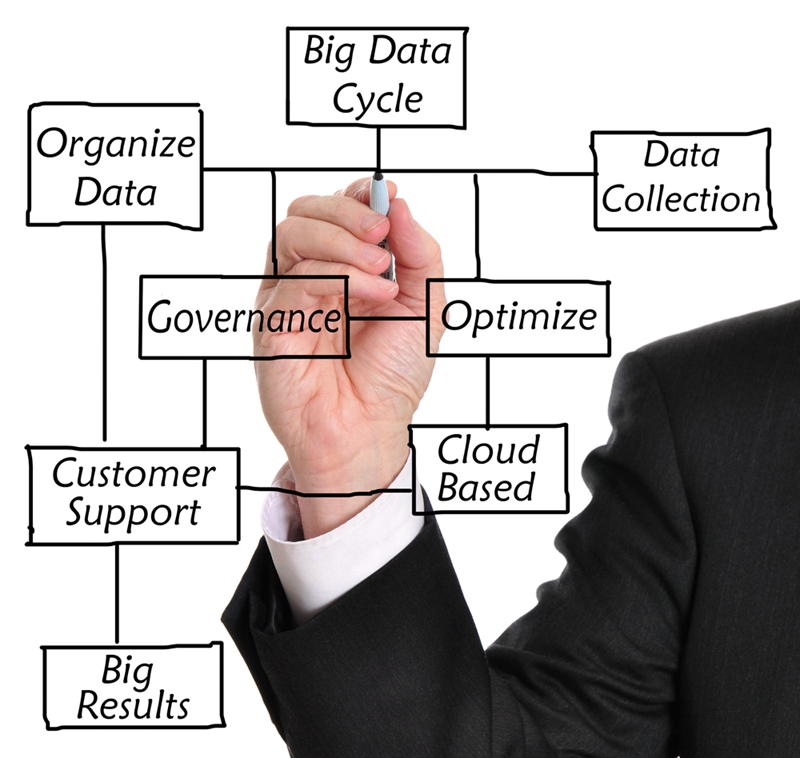Using big data to save on printing costs

From informing the steps of your digital transformation to setting key performance indicators in marketing strategies, data and analytics are at the heart of almost every important business decision your organisation makes.
However, some still fail to realise that the collection and scrutiny of statistics can also improve everyday internal processes, making them more efficient and less costly.
Today, we’ll be looking at how data, and specifically big data, can be used to benefit one internal process in particular – printing. By the end, you’ll have an easy to follow guide on how to apply big data to your own printing requirements in order to cut down on unnecessary expenditure.

What is big data?
Every organisation is flooded by huge amounts of data on a daily basis. Some of this information is structured, for example client contact details or inventory control information, while some is unstructured – think email message fields, phone recordings and particulars from business applications such as MS Office.
The term big data refers to all of this – adding up to data sets which are truly enormous in size.
Doug Laney, Vice President and Distinguished Analyst with Gartner’s Data and Analytics research and advisory group, helped bring the concept of big data to the fore in 2001 by defining it through the lens of the Three Vs:
- Volume: Technological innovation has given today’s businesses access to unparalleled quantities of data. Crucially, applications such as the cloud have also provided means to store and search these colossal datasets
- Velocity: Not only is more data coming in than ever before, it’s coming in incredibly quickly. This means that organisations have to deal with the data in a timely way if they’re to benefit from it. In reality, this is getting closer and closer to real-time data analysis
- Variety: This is the structured vs. non structured element. Not all data is easy to process and efficiently store for future use, but it’s worth putting in the effort to gain maximum insights into how you can improve your systems and processes

Big data and printing: The workflow
While the Three Vs are important in understanding what we’re talking about in this article, it’s what organisations do with big data that we’re really interested in. Used effectively, big data can allow you to cut costs, increase efficiency, and make smart decisions for the future. Here’s how the workflow usually looks:
Step 1: Begin internal data collection
A staggering 90% of companies don’t track print costs at all, according to Buyer’s Laboratory, so if your organisation has predominantly only targeted customer data in the past, you’ll likely need to start by identifying which metrics you want to target internally. This will allow you to discover how your personnel are using office printers, and where current inefficiencies and wastage lie.
Most organisations use print management software to automatically collect data on their printers, though this harvesting is something you can outsource if you prefer. While outsourcing adds a cost, it can be a great way to start learning more about data process and data collection if this is something entirely new to you.
A staggering 90% of companies don’t track print costs at all
If you choose to go the print management software route, you’ll be able to apply this at a fleet level to get a company wide understanding of current practices. However, as big data is all about creating the best possible data sets, you’ll also need to draw on information that comes from outside the devices themselves. For example, if you want to discover whether your current setup is causing productivity bottlenecks for your employees, a survey of how much of their time is wasted dealing with printer issues would be a useful metric to track. We’ll give some more tips on what data to collect in the last section of this article.
Step 2: Mine that data
Data mining is an expression you’ll often come across in big data contexts that refers to an interdisciplinary approach for discovering patterns and relationships in large sets of data. These findings can then be used to make predictions about future trends. Data mining uses a combination of artificial intelligence (AI), machine learning and statistics to solve a predefined problem, and can be applied to both structured and non structured data.
There are four common data mining techniques:
- Dependency modelling: Hunting for pre-existing relationships within your dataset
- Anomaly detection: Seeking out unusual values
- Clustering: Highlighting structures within unstructured data
- Classification: Generalising these known structures and applying them to the dataset
The computer assisted process of data mining is what allows businesses to really harness big data, as it gives insights into problems with your operations that were previously too time consuming to resolve. Therefore, it’s worth really taking your time at this phase – data mining will demonstrate connections between factors you previously thought couldn’t be linked, but these patterns will only emerge if sufficient time is dedicated.

Step 3: Analyse that data
With your data collected and mined, you now need to analyse it. Data mining and data analytics are often used interchangeably with reference to big data, however they’re actually two separate stepping stones in the process.
While data mining will find find patterns and structures within vast datasets, it doesn’t create visualisations of data needed for analytics. To do this, you need to extract the sections you’re interested in and analyse them. There are heaps of analytics software packages out there that will allow you to do this effectively, and will leave you with insights from which you can formulate strategic plans.
Step 4: Take action
Everything you’ve done so far has been in preparation for this step. This is where you take what you’ve learnt about your business from the previous stages and translate into meaningful action to reduce costs.
The sheer volume of information and work that has gone into providing you with these models for change means that you can make decisions with confidence. What’s more, big data provides you with an excellent business case to support your proposed action if you need to seek support from key stakeholders.
Step 5: Measure your outcomes
It’s not game over once your new systems and processes are in place. Instead, you should continue to monitor your data streams to ensure that your new approach is working and that improvements are maintained in the longer term.
You’ll also be able to keep updating your printing customs as the business evolves. New technologies, personnel or organisational objectives can all impact how you use your printers, and with big data behind you, you can ensure your fleet moves with the times whilst remaining efficient and cost effective.

Using big data to save on printing costs: What data should I collect?
While every business is different in terms of their printing needs, there are generally four types of data you should be looking to collect to gain a holistic image of your printing needs and improve your current approach:
1. Document data
Where do your printed documents end up? For example, are they usually copied, shared and stored somewhere, or do they ultimately find their way to in the shredder?
One of the best ways to save money on printing is to reduce how often you do it, and big data can help you achieve this. By seeking out statistics on the way printed documents are used, you can create guidelines to inform staff on what they should and should not be printing. This will help you eliminate wasteful practices by exploring digital solutions such as cloud storage and sharing.
2. User data
This looks at the behaviours around where, when and how personnel are printing.
For example, a key insight that can be gained by exploring user data is discovering which department is responsible for the highest printing costs within your organisation. This again can highlight unnecessary printing, allowing you to discuss habits with team leaders in order to lower their contribution to your overall printing expenditure. On the flipside, if one team simply needs to print more than others, you can review the physical locations of your devices to ensure those who need them have quick and easy access.
User data can show you which departments are responsible for the majority of your printing expenses
Another important insight you can glean from user data is which tasks would benefit from automation. For example, if your staff are regularly experiencing hold ups because too many individuals are trying to print from one device simultaneously, investing in AI software that will automatically reroute jobs to available printers could result in a significant productivity improvement.
3. Device data
Device data is most traditionally associated with making your printer fleet more environmentally sustainable. However, given that many of these goals boil down to reducing consumable wastage and lowering energy consumption, there are clear crossovers with cost cutting objectives.
You can learn information such as:
- Device usage: If your device data shows that certain devices aren’t being used, and your user data doesn’t point to bottlenecks in print jobs, you may have the personnel to printer ratio wrong. By removing unnecessary devices, you’ll be saving yourself on energy costs, as well as freeing up space in the office. In addition to this retrospective improvement, you can use this data proactively to inform you how many devices you’re likely to need if the business expands and takes on more personnel
- Performance statistics: If some devices are burning through consumables or power much faster than others, this is a good indicator that something is wrong. Big data, therefore, allows you to take steps to repair your printers before they fully breakdown, or could show you that it’s time to update to a more modern, efficient printer fleet
- Spikes in demand: You may not have realised it, but certain activities, for example cyclical marketing campaigns, can cause regular spikes in printer demand. With big data, you can highlight these, investigate whether all printing practices are necessary and ensure you always have the consumable stock necessary to cope.

4. Process data
Process data monitors printing activity and records who is responsible for it at each step, in doing so it reveals some of the same inefficiencies as both document and user data. However, it’s real contribution is in laying out the the time and costs associated with each process and measuring the value returned to the business.
From a cost-cutting point of view, this might be the most important single metric as it presents an easy starting point from which you can cull non-essential printing that isn’t delivering ROI to your organisation.
By intersecting and analysing the vast quantities of data on your company’s printing processes and practices, big data provides a real opportunity for businesses to cut unnecessary costs and improve their bottom line in the long term. For more information on how Brother can help you find a print solution that will conform to your objectives while remaining on budget, get in touch with our team of experts today.

Resource Library
Be the first to receive exclusive offers and the latest news on our products and services directly in your inbox




.jpg?h=720&iar=0&w=1920&rev=36358aeeea934b07bce65a5d230d3519)